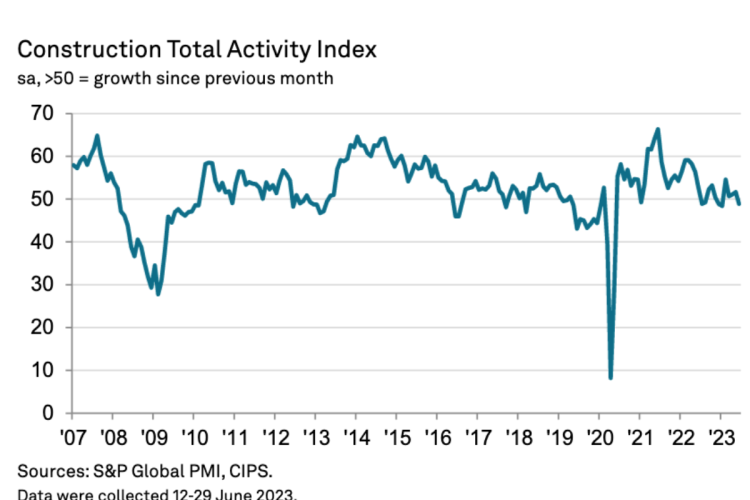The seasonally-adjusted S&P Global/CIPS UK Construction Purchasing Managers’ Index (PMI) hit 48.9 in June, down from 51.6 the previous month and falling below the 50.0 no-change threshold for the first time since January.
Residential work (index at 39.6) decreased at the steepest pace since May 2020. Aside from the lockdown-related fall in house building, the rate of contraction was the fastest since April 2009. Survey respondents widely commented on weaker demand due to rising borrowing costs and a subdued outlook for the housing market.
Civil engineering was the best-performing segment (index at 53.1), with business activity rising at the second-fastest pace since June 2022. Commercial building also increased in June (index at 53.0), although the rate of growth slipped to a three-month low.
On a more positive note, softer demand and fewer supply bottlenecks resulted in the sharpest improvement in delivery times for construction inputs since July 2009. This also contributed to an outright decline in purchasing prices for the first time in thirteen-and-a-half years.
Construction companies cited lower fuel, steel and timber prices, alongside more competitive market conditions in response to falling demand. Meanwhile, sub-contractor charges increased at the slowest pace for 31 months.
Construction firms signalled a downturn in business confidence for the third month running in June. Weaker optimism about future workloads mostly reflected concerns related to rising interest rates and subdued housing market conditions.
Tim Moore, economics director at S&P Global Market Intelligence, which compiles the survey said: "Weaker housing market conditions in the wake of higher borrowing costs acted as a major constraint on UK construction output in June.
“Aside from the lockdown-related fall in house building, the rate of decline was the fastest for just over 14 years. Survey respondents widely commented on cutbacks to new residential building projects and more caution among clients in response to rising interest rates.

"Solid rates of output growth in the commercial and civil engineering segments helped to offset some of the weakness in residential construction. Higher levels of business activity were attributed to resilient demand for refurbishment projects in the commercial construction sector and robust infrastructure workloads.
"Construction companies experienced an outright decline in their purchasing prices during June, which contrasted with the rapid rates of cost inflation seen over the past three years. Anecdotal evidence suggested that more competitive market conditions and improved materials availability had helped to bring down inflationary pressures.
Supply constraints continued to ease in the latest survey period, as signalled by the fastest improvement in delivery times for construction inputs since July 2009."
Responding to the figures, the Federation of Master Builders (FMB) said that the government needs to give a clear commitment to building new homes.
FMB chief executive Brian Berry said: “At a time when we need to be building more homes we are moving in the opposite direction and building fewer. There is a whole generation of people who can’t get on the housing ladder, which is holding back growth and investment. While it might be politically easy to shelve housing commitments to gain votes in some areas, the government must recommit to their annual housing target of 300,000 homes.”
Paul Sloman, sector lead for engineering and construction with accountancy firm PwC, said: “May 2020 aside, the rate of residential contraction is the fastest since April 2009, and the survey noted respondents citing weaker demand due to rising borrowing costs and a subdued outlook for the housing market. It’s important that this update is taken into consideration as a potential warning sign for the sector - as homeowners continue to face economic uncertainty with rising mortgage costs and reduced availability - which in turn is causing a considerable disruption to sales and will be a hindering factor when considering the pace of new projects getting underway.
However Sloman noted that shortening delivery times is better news for supply chains: “The PMI noted that this latest improvement in vendor performance was the strongest for around 14 years, which is a testament to the continued resilience and agility we see in the sector - given the overall operating environment continues to pose challenges from both an economic and policy perspective.
“June’s data signalled the first outright reduction in average cost burdens since January 2010, with a marginal decline in overall input prices across the sector. However, it’s important to consider that this may well be due to lessening demand for materials amidst continued concern and strained optimism about future projects.”
Got a story? Email news@theconstructionindex.co.uk



